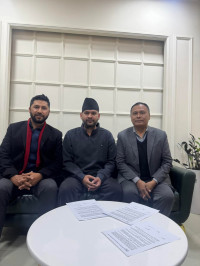Opinion
National identity and belonging
Social anthropologists are familiar, at least since Diana Forsythe’s analysis of German identity, that what looks from the outside like a singular national identity,
David N Gellner
Social anthropologists are familiar, at least since Diana Forsythe’s analysis of German identity, that what looks from the outside like a singular national identity, what is supposed to be a nation of equal citizens, is in practice, and in the way people experience it, a hierarchy. Certain people are considered more German than others (those from the old West Germany more so than the ‘Ossies’ from the old East Germany; both of these being more central than descendants of German ancestors living in other east European countries). Thus, there are, at the level of everyday interaction and unthinking assumption, gradations of German-ness (and the same goes for any other national identity). Some belong more than others. Another way to put this is to say that national identities usually have an ‘ethnic core’.
The Nepali nation
We can adapt this model to the present case and posit a paradigmatic core of unofficial Nepali identity, based in the traditions, language, and culture of the Bahuns and Chhetris. In a second ring around this core, the culture of the Janajatis is accepted as contributing to the ‘authentic mix’ of Nepal, particularly in the area of music and folk dancing. Some Janajatis may be considered more ‘central’ than others. Thus the Magars and Gurungs, who have long had a close link to the ruling elite and have provided many of the foot soldiers both in the Nepal Army and in the Gurkhas of the British and Indian armies, may be said to belong to this historic national core. At the same time, Bahuns and Chhetris from the Far West region of the country often feel marginalised and indeed receive recognition as such, in terms of reservations and other economic facilities.
The Newars, traditional inhabitants of the Kathmandu Valley, tend to resent being relegated to this second circle. They view themselves as simultaneously central (because of their ancient culture and association with the Kathmandu Valley) and disadvantaged (therefore deserving the label ‘Janajati’). Tamangs, situated close to the capital but deprived of development, are a kind of rural proletariat, kept backward by the Ranas in order to provide porters, servants, and concubines. Dalits, who played a key role in spreading Hindu ideas of hierarchy among Janajati populations, occupy a ring further out.
The people of Tibetan and Indian culture (Bhotiyas and Madhesis respectively) are considered even further away from the heart of ‘Nepaliness’ than even this. Some do not regard them as Nepali at all. This is especially difficult for Madhesis, identified by culture and language with India, the principal ‘other’ against which Nepali nationalists seek to define themselves. Some Madhesis, led by CK Raut, have concluded that they will never be accepted as Nepali. Other minorities, such as Dalits (conceptualised mainly in terms of what they lack), and Muslims, fit into this model at different points depending on the contexts; explicitly or implicitly both groups are often excluded from representations of belonging to the Nepali nation.
This hierarchy of belonging within the nation had no place in the pays légal during the Panchayat period (1960-1990). Officially, everyone was now equal and caste had no status before the law. But, nonetheless and surreptitiously, Bahun-Chhetri models dominated the construction of the Nepali version of the educated and developed person. The national language was their language and the one national dress (referred to in the slogan above) was their shirt (daura/labeda), baggy trousers (suruwal), and Nepali cap (topi), or at least so it seemed to the minorities.
Nation- and ethnicity-building
With the 1990 People’s Movement, Nepal entered a new world of freedom and public openness, one where for the first time in 30 years political parties could organise and compete in elections, and where ethnic groups and castes could come together in a way that had not been possible before. Politics, especially party politics, became pervasive. If the period of 1960 to 1990 was one of nation-building, the years since then have been a time of ethnicity-building. A key part of the process of creating new ethnic identities has been to perform them in everyday life, by inventing new ethnically inflected ways of greeting (thus ‘Jwajalpa’ for Newars, ‘Sevaro’ for Limbus’, ‘Pyaphulla’ for Tamangs, and so on). Another crucial modality was to hold big ceremonies, to perform ethnicity in a very public way, and to create new, specifically ethnic public holidays (especially celebrations of the New Year).
A completely new terminology started to emerge, a new way of grouping castes and ethnic groups into large blocs or, as I call them, macro-categories. Four major ethnic macro-categories have emerged, all with new names that were not in general use before 1990: Janajati, Madhesi, Dalit, and Khas-Arya. ‘Janajati’ is a neologism borrowed from Hindi and/or Bengali for those groups who were formerly known as ‘hill tribes’, though they include the Tharus, and other smaller groups, who inhabit the Tarai belt. ‘Madhesi’ refers to the plainspeople of Indian cultural and linguistic background; of the four macro-categories it is the one with the most fluid denotation: it is highly contested whether Muslims and/or Tharus are full members of the category or not. ‘Dalit’ is the term, also borrowed from India, for those groups who used to be considered Untouchable. (It is by no means universally liked by Dalits themselves; but there is no widely accepted alternative.) ‘Khas-Arya’ is the most recent neologism to emerge and refers to the former ‘high’ castes of the hills, i.e., Bahuns, Chhetris, and allied small castes (such as Thakuri and Sanyasi).
At the borders
The five macro-categories break down into three larger groups—Khas-Arya, Janajati, and Madhesi—comprising about 31 per cent, 36 per cent, and 15 per cent, respectively, and two smaller ones: Dalits (13 per cent) and Others (5 per cent). If Tarai Dalits, Tarai Janajatis, and Tarai Muslims are included, the Madhesi total increases to 32 per cent. This roughly means the three major groups in the country, the Khas-Aryas, the Janajatis, and the Madhesis, are all somewhere around one third of the total. It is probably no coincidence that there is more than a passing resemblance between Nepal’s macro-categories and the large electoral blocs that are familiar to students of north India: ‘forward’ castes, OBCs (the ‘Other Backward Classes’), Muslims, and SCs (‘Scheduled Castes’, i.e., Dalits).
The main and obvious difference between India and Nepal is that in Nepal the ‘tribals’ replace OBCs, because in most of north India the STs (‘Scheduled Tribes’) are few and far between. At the same time, presumably because the Nepali terminology has been worked out right at the end of the 20th century rather than 50 or more years earlier, it lacks the overtly evolutionist overtones (‘forward’, ‘backward’) of the Indian concepts. Rather, the language in Nepali is spatialising, talking of exclusion, marginalisation, or ‘pushing to the border’/‘bordering’ (simantikrit). This reminds us that indeed many of the excluded groups are to be found near Nepal’s very long borders with Tibet and India. Even those who are not at the borders of the country are often pushed to the borders of settlements.
- Gellner is Professor of Anthropology, University of Oxford. This text has been extracted from the 2016 Mahesh Chandra Lecture delivered in Kathmandu on 11 December, 2016. The full lecture is available at http://soscbaha.org/activities/lectures/mahesh-chandra-regmi-lecture/884-mcrl2016.html




 6.12°C Kathmandu
6.12°C Kathmandu










%20(1).jpg&w=300&height=200)

